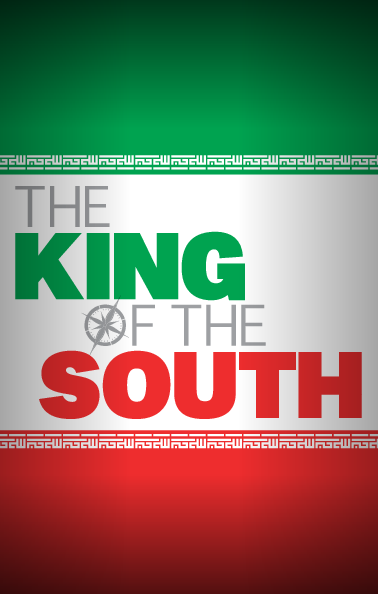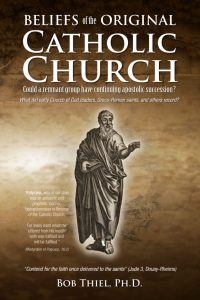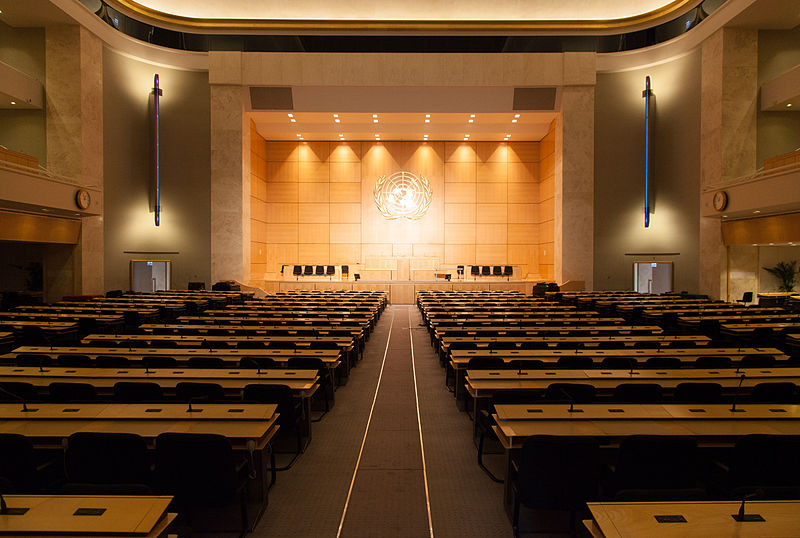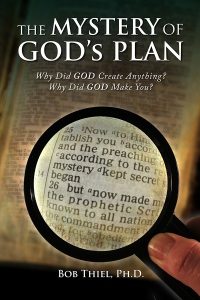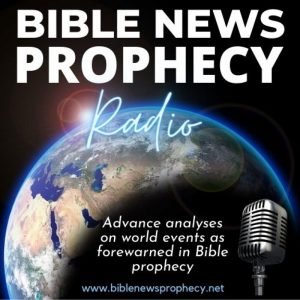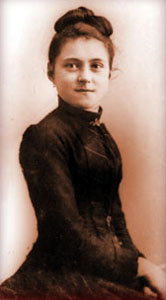
Thérèse at age 15
COGwriter
The Bible prophesies that there will be signs and lying wonders:
9 The coming of the lawless one is according to the working of Satan, with all power, signs, and lying wonders,
10 and with all unrighteous deception among those who perish, because they did not receive the love of the truth, that they might be saved.
11 And for this reason God will send them strong delusion, that they should believe the lie,
12 that they all may be condemned who did not believe the truth but had pleasure in unrighteousness. (2 Thessalonians 2:9-12)
Now, consider that Thérèse of Lisieux was canonized as a Roman Catholic saint on May 17, 1925, by Pope Pius XI. She died in 1897. She became quite popular in the 20th century and is still popular now.
Her remains have traveled the world. They have been viewed, adored, worshiped and prayed to by various Roman Catholics in more than 40 nations. Some claim her remains have even restored sight to the blind. Several years ago, about two million turned out to see St. Terese’s remains when they were in Ireland (The Independent, August 23, 2009).
Here is some of what Catholic OnLine reported about her:
Over the years, some modern Catholics have turned away from her because they associate her with over- sentimentalized piety…
Therese became so ill with a fever that people thought she was dying. The worst part of it for Therese was all the people sitting around her bed staring at her like, she said, “a string of onions.” When Therese saw her sisters praying to statue of Mary in her room, Therese also prayed. She saw Mary smile at her and suddenly she was cured. She tried to keep the grace of the cure secret but people found out and badgered her with questions about what Mary was wearing, what she looked like. When she refused to give in to their curiosity, they passed the story that she had made the whole thing up…
Every time Therese even imagined that someone was criticizing her or didn’t appreciate her, she burst into tears. Then she would cry because she had cried! Any inner wall she built to contain her wild emotions crumpled immediately before the tiniest comment. http://www.catholic.org/saints/saint.php?saint_id=105
Both biblical (2 Thessalonians 2:9-12) and non-biblical sources suggest that signs and wonders will deceive many at the end. I believe that she, partially because of her promoting her false view of Jesus’ mother Mary, but also because of other false doctrines she promoted, has been used as part of Satan’s Plan.
Some of the warnings of the Bible about lying wonders will likely involve apparitions claiming to be Mary as well as people who have claimed to somehow see Mary.
The prevalence of such claims this century even caused the Vatican to issue statements and policies warning against many of them (see Mary, the Mother of Jesus and the Apparitions).
It needs to be emphasized that just because a Roman Catholic nun claims to have seen Mary and passes on messages, that this does not mean that the messages are from God–and even the Church of Rome teaches that (for some documentation please see Greco-Roman Catholic Prophecies: Do They Mirror, Highlight, or Contradict Biblical Prophecies?).
In August 1895, in her “Canticle to the Holy Face” Thérèse wrote:
“Jesus, Your ineffable image is the star which guides my steps. Ah, You know, Your sweet Face is for me Heaven on earth. My love discovers the charms of Your Face adorned with tears. I smile through my own tears when I contemplate Your sorrows”. (Wikipedia)
This should set off warnings to all as the reality is that she never actually saw Jesus’ face/image, hence to claim that it was His image that guided her steps cannot be correct.
The Apostle John wrote:
1 Beloved, do not believe every spirit, but test the spirits, whether they are of God; because many false prophets have gone out into the world (1 John 4:1).
And that is what all should do. God’s true prophets do not ever claim God told them something and then been shown to have been in error.
Thérèse of Lisieux is popularly known as “The Little Flower of Jesus” or “The Little Flower.” She was declared a Roman Catholic ‘doctor of the church’ in 1997.
Pope Francis considers that the deceased Thérèse of Lisieux responded to his request for peace through his version of ‘Mary’ back in 2013:
On Sunday 8 September, the day after the long prayer vigil for peace in Syria – when some passages from texts written by Saint Thérèse of Lisieux were read out – Pope Francis received a white rose as a surprise. Francis considers the flower to be a “sign” linked to the devotion of the saint. The Archbishop of Ancona and Osimo, Edoardo Menichelli broke the news, with Francis authorisation…
“The Pope told me he received the freshly-picked white rose out of the blue from a gardener as he was taking a stroll in the Vatican Gardens on Sunday 8 September,” Mgr. Menichelli said. “The Pope sees this flower as a “sign”, a “message” from Saint Thérèse of Lisieux, whom he had turned to in a moment of worry the day before.”…
Bergoglio mentions it in “El Jesuita” (“The Jesuit”), a book interview written by Sergio Rubin and Francesca Ambrogetti when he was still a cardinal. In a description the two journalists give of Bergoglio’s library in Buenos Aires, they write: “We pause before a vase full of white roses standing on a shelf in the library. In front of it is a photograph of Saint Thérèse. “Whenever I have a problem,” Bergoglio explained to the journalists, “I ask the saint not to solve it, but to take it into her hands and to help me accept it and I almost always receive a white rose as a sign.” Pope Francis’ devotion for the Carmelite mystic who died at the young age of 24 in 1897, was canonized by Pius XI and proclaimed a Doctor of the Church by John Paul II in 1997, is common knowledge. http://vaticaninsider.lastampa.it/en/the-vatican/detail/articolo/28151/
We are increasingly learning about supposed ‘signs’ associated with Pope Francis. This should give pause to those in the real Church of God:
24 For false christs and false prophets will rise and show great signs and wonders to deceive, if possible, even the elect. 25 See, I have told you beforehand. (Matthew 24:24-25; cf. 2 Thessalonians 2:9-12).
Pope Francis is a big promoter of Mary as well as the apparition in Fatima. He consecrated his pontificate to ‘Mary’ and even further had his pontificate consecrated to the Lady of Fatima (Pope Francis’ pontificate consecrated to ‘Lady of Fatima’). Now as far as ‘peace’ coming to Syria, what happened back in 2013 is that the USA decided not to intervene militarily because of Syrian use of chemical weapons–this did not lead to peace–instead it got opposition leaders to Syria’s President Assad to turn further away from the USA, and ultimately support the group calling itself the Islamic State. Thus, the flower ‘sign’ that Pope Francis allegedly received from Thérèse of Lisieux was not of God.
Thérèse of Lisieux was not a true prophet of God (see How To Determine If Someone is a True Prophet of God), but instead is one of many throughout history that seems to have been used to set people up for the deception that is still going to come (Matthew 24:24) who do not truly have the “love of the truth” (2 Thessalonians 2:8-12).
That said, notice the following:
The Vatican’s doctrine office will publish a new document … on discerning Marian apparitions and other supernatural events. …
Cardinal Víctor Manuel Fernández, the prefect of the Dicastery for the Doctrine of the Faith (DDF), will unveil new norms for discernment regarding “apparitions and other supernatural phenomena” on Friday, May 17.
In an interview with the National Catholic Register, CNA’s sister news partner, last month, Fernandez said that the document will provide “clear guidelines and norms” for discernment.
The new norms will be the first time that the Vatican’s doctrinal office has issued a general document on apparitions in four decades. Pope Paul VI approved norms on “the discernment of presumed apparitions or revelations” in 1978. 05/-7/24 https://www.catholicnewsagency.com/news/257600/vatican-to-publish-new-document-on-marian-apparitions-next-week
What those guidelines SHOULD SAY would be that 1) the dead know nothing (Ecclesiastes 9:5) hence are not appearing 2) messages that contradict the Bible are fraudulent and may come from demons, and 3) likely all Roman Catholic accepted apparitions are demonic or frauds.
Now here is what they do say in a document with today’s date at the Vatican’s website:
These six possible determinations allow the Dicastery and the Bishops to handle in a suitable manner the issues that arise in connection with the diverse cases they encounter.
As a rule, these potential conclusions do not include the possibility of declaring that the phenomenon under discernment is of supernatural origin—that is, affirming with moral certainty that it originates from a decision willed by God in a direct way. Instead, as Pope Benedict XVI explained, granting a Nihil obstat simply indicates that the faithful “are authorized to give [the phenomenon] their adhesion in a prudent manner.” Since a Nihil obstat does not declare the events in question to be supernatural, it becomes even more apparent—as Pope Benedict XVI also said—how the phenomenon is only “a help which is proffered, but its use is not obligatory.”[5] At the same time, this response naturally leaves open the possibility that, in monitoring how the devotion develops, a different response may be required in the future.
Moreover, it should be noted that reaching a declaration affirming the “supernaturalness” of an event, by its very nature, not only requires a suitable amount of time to carry out the analysis but it can also lead to the possibility that a judgment of “supernatural” today might become a judgment of “not supernatural” years later—and precisely this has happened. An example worth recalling is a case involving alleged apparitions from the 1950s. In 1956, the Bishop issued a final judgment of “not supernatural,” and the following year, the Holy Office approved the Bishop’s decision. Then, the approval of that veneration was sought again. In 1974, the Congregation for the Doctrine of the Faith declared the alleged apparitions to be “constat de non supernaturalitate.” Thereafter, in 1996, the local Bishop positively recognized the devotion, and in 2002, another Bishop from the same place recognized the “supernatural origin” of the apparitions, leading to the spread of the devotion to other countries. Finally, in 2020, at the request of the Congregation, a new Bishop reiterated the Congregation’s earlier “negative judgment,” requiring the cessation of any public disclosures regarding the alleged apparitions and revelations. Thus, it took about seventy excruciating years to bring the whole matter to a conclusion.
Today, we have come to the conviction that such complicated situations, which create confusion among the faithful, should always be avoided. This can be accomplished by ensuring a quicker and clearer involvement of this Dicastery and by preventing the impression that the discernment process would be directed toward a declaration of “supernaturalness” (which carries high expectations, anxieties, and even pressures). Instead, as a rule, such declarations of “supernaturalness” are replaced either by a Nihil obstat, which authorizes positive pastoral work, or by another determination that is suited to the specific situation.
The procedures outlined in the new Norms, which offer six possible final prudential decisions, make it possible to reach a decision in a more reasonable period, helping the Bishop to manage a situation involving events of alleged supernatural origin before such occurrences—without a necessary ecclesial discernment—acquire very problematic dimensions.
Nevertheless, the possibility always remains that the Holy Father may intervene exceptionally by authorizing a procedure that includes the possibility of declaring the supernaturalness of the events. Yet, this is an exception that has been made only rarely in recent centuries.
At the same time, as stipulated in the new Norms, the possibility of declaring an event as “not supernatural” remains, but only when there are objective signs that clearly indicate manipulation at the basis of the phenomenon. For instance, this might occur when an alleged visionary admits to having lied or when evidence shows that the blood on a crucifix belongs to the alleged visionary. …
10. By following the Norms below, the Church will be able to fulfill its duty of discerning: (a) whether signs of a divine action can be ascertained in phenomena that are alleged to be of supernatural origin; (b) whether there is that anything conflicts with faith and morals in the writings or messages of those involved in the alleged phenomena in question; (c) whether it is permissible to appreciate their spiritual fruits, whether they need to be purified from problematic elements, or whether the faithful should be warned about potential risks; (d) whether it is advisable for the competent ecclesiastical authority to realize their pastoral value.
11. While the following provisions foresee the possibility of a discernment in the sense described in Par. 10 (above), it must be noted that, as a general rule, it is not foreseen in these Norms that ecclesiastical authority would give a positive recognition of the divine origin of alleged supernatural phenomena.
12. Whenever a Nihil obstat is granted by the Dicastery (cf. Par. 17, below), such phenomena do not become objects of faith, which means the faithful are not obliged to give an assent of faith to them. Rather, as in the case of charisms recognized by the Church, they are “ways to deepen one’s knowledge of Christ and to give oneself more generously to him, while rooting oneself more and more deeply in communion with the entire Christian people.”[15]
13. Even when a Nihil obstat is granted for canonization processes, this does not imply a declaration of authenticity regarding any supernatural phenomena present in a person’s life. This is evident, for instance, in the decree of canonization of St. Gemma Galgani: “[Pius XI] feliciter elegit ut super heroicis virtutibus huius innocentis aeque ac poenitentis puellae suam mentem panderet, nullo tamen per praesens decretum (quod quidem numquam fieri solet) prolato iudicio de praeternaturalibus Servae Dei charismatibus.”[16]
14. At the same time, it should also be acknowledged that some phenomena, which could have a supernatural origin, at times appear connected to confused human experiences, theologically inaccurate expressions, or interests that are not entirely legitimate.
15. The discernment of alleged supernatural phenomena is carried out from the start by the Diocesan Bishop (or by another ecclesiastical authority mentioned in Part II, Arts. 4-6) in dialogue with the Dicastery. However, since special attention to the common good of the entire People of God can never be lacking, “the Dicastery reserves the right to evaluate the moral and doctrinal elements of that spiritual experience and the use that is being made of it.”[17] It is important not to overlook that sometimes the discernment may also deal with problems, such as delicts, manipulation, damage to the unity of the Church, undue financial gain, and serious doctrinal errors that could cause scandals and undermine the credibility of the Church.
B. Conclusions
16. The discernment of alleged supernatural phenomena may reach conclusions that are usually expressed in one of the terms listed below.
17. Nihil obstat – Without expressing any certainty about the supernatural authenticity of the phenomenon itself, many signs of the action of the Holy Spirit are acknowledged “in the midst”[18] of a given spiritual experience, and no aspects that are particularly critical or risky have been detected, at least so far. For this reason, the Diocesan Bishop is encouraged to appreciate the pastoral value of this spiritual proposal, and even to promote its spread, including possibly through pilgrimages to a sacred site.
18. Prae oculis habeatur – Although important positive signs are recognized, some aspects of confusion or potential risks are also perceived that require the Diocesan Bishop to engage in a careful discernment and dialogue with the recipients of a given spiritual experience. If there were writings or messages, doctrinal clarification might be necessary.
19. Curatur – While various or significant critical elements are noted, at the same time, the phenomenon has already spread widely, and there are verifiable spiritual fruits connected to it. In this situation, a ban that could upset the People of God is not recommended. Nevertheless, the Diocesan Bishop is asked not to encourage this phenomenon but to seek out alternative expressions of devotion and possibly reorient its spiritual and pastoral aspects.
20. Sub mandato – In this category, the critical issues are not connected to the phenomenon itself, which is rich in positive elements, but to a person, a family, or a group of people who are misusing it. For instance, the spiritual experience may be exploited for particular and undue financial gain, committing immoral acts, or carrying out a pastoral activity apart from the one already present in the ecclesiastical territory without accepting the instructions of the Diocesan Bishop. In this situation, the pastoral leadership of the specific place where the phenomenon is occurring is entrusted to the Diocesan Bishop (or to another person delegated by the Holy See), who, if unable to intervene directly, will try to reach a reasonable agreement.
21. Prohibetur et obstruatur – While there are legitimate requests and some positive elements, the critical issues and risks associated with this phenomenon appear to be very serious. Therefore, to prevent further confusion or even scandal that could erode the faith of ordinary people, the Dicastery asks the Diocesan Bishop to declare publicly that adherence to this phenomenon is not allowed. At the same time, the Diocesan Bishop is asked to offer a catechesis that can help the faithful understand the reasons for the decision and reorient the legitimate spiritual concerns of that part of the People of God.
22. Declaratio de non supernaturalitate – In this situation, the Dicastery authorizes the Diocesan Bishop to declare that the phenomenon is found to be not supernatural. This decision must be based on facts and evidence that are concrete and proven. For instance, if an alleged visionary admits to having lied or if credible witnesses provide elements of proof that allow one to discover that the phenomenon was based on fabrication, an erroneous intention, or mythomania.
23. In light of the aforementioned points, it is reaffirmed that, as a rule, neither the Diocesan Bishop, nor the Episcopal Conferences, nor the Dicastery will declare that these phenomena are of supernatural origin, even if a Nihil obstat is granted (cf. Par. 11, above). It remains true, however, that the Holy Father can authorize a special procedure in this regard. https://press.vatican.va/content/salastampa/it/bollettino/pubblico/2024/05/17/0403/00842.html#en
The above misses many scriptural points.
Yet, because signs and lying wonders are prophesied to occur, the document above will allow for demonic source messages to be accepted, though it will not say demonic.
And yes, I expect ‘Marian apparitions’ in the future that will deceive many.
Some items of related interest may include:
Mary, the Mother of Jesus and the Apparitions Do you know much about Mary? Are the apparitions real? What happened at Fatima? What might they mean for the rise of the ecumenical religion of Antichrist? Are Protestants moving towards Mary? How do the Eastern/Greek Orthodox view Mary? How might Mary view her adorers? Here is a link to a YouTube video Marian Apparitions May Fulfill Prophecy. Here is a link to a sermon video: Why Learn About Fatima?
Satan’s Plan Does Satan have a plan? What is it? Has it already been successful? Will it be successful in the future? Here are links to a two-part sermon series: What are Some of the Parts of Satan’s Plan? and Satan’s Plan is More Dramatic than Many Realize.
The Great Monarch: Biblical and Catholic Prophecies Is the ‘Great Monarch’ of Catholic prophecies endorsed or condemned by the Bible? Two sermons of related interest are also available: Great Monarch: Messiah or False Christ? and Great Monarch in 50+ Beast Prophecies.
Feast of the Immaculate Conception? Did early Christians teach Mary had an immaculate conception and led a sinless life?
Origin of the Marian Dogmas: Where Do Catholic Scholars Say The Four Dogmas of Mary Came From?
Assumption of Mary Did Mary die? Was she taken to heaven on August 15th? What is known? What does the Bible show?
The ‘Lady’ of Guadalupe: Any Future Ramifications? It is claimed that a female apparition appeared near Mexico City on December 12, 1531. How has it affected the world? What might it suggest about the future? A video of related interest is titled: The ‘Lady of Guadalupe’ and Prophecy.
Pope Francis: Could this Marian Focused Pontiff be Fulfilling Prophecy? Pope Francis has taken many steps to turn people more towards his version of ‘Mary.’ Could this be consistent with biblical and Catholic prophecies? This article documents what has been happening. There is also a video version titled Pope Francis: Could this Marian Focused Pontiff be Fulfilling Prophecy?
Fatima Shock! What the Vatican Does Not Want You to Know About Fatima, Dogmas of Mary, and Future Apparitions. Whether or not you believe anything happened at Fatima, if you live long enough, you will be affected by its ramifications (cf. Isaiah 47; Revelation 17). Fatima Shock! provides concerned Christians with enough Catholic-documented facts to effectively counter every false Marian argument. In addition to the print version, there is a Kindle version of Fatima Shock! which you can acquire in seconds.
Greco-Roman Catholic Prophecies: Do They Mirror, Highlight, or Contradict Biblical Prophecies? People of all faiths may be surprised to see what various Roman and Orthodox Catholic prophets have been predicting as many of their predictions will be looked to in the 21st century.
The Falling Away: The Bible and WCG Teachings Who is 2 Thessalonians 2:3 referring to? Are there multiple falling aways? Here is a related link in Spanish/español: La Apostasía: Enseñanzas de la Biblia y de la WCG. There are also two YouTube videos on the subject that you can watch The Falling Away Part 1: From the Bible and Church History and The Falling Away Part 2: Positions Presented by Others.
Who is the Man of Sin of 2 Thessalonians 2? Is this the King of the North, the ten-horned beast of Revelation 13:1-11, or the two-horned Beast of Revelation 13:12-16? Some rely on traditions, but what does the Bible teach? Here is a related link in Spanish/español: ¿Quién es el Hombre de Pecado de 2 Tesalonicenses 2?; here is a link to a video in Spanish: ¿Quién es el ‘hombre de pecado’? Here is a version in Mandarin: N;�ÿ� Œ�f/’Y’jNº’ÿ� Here is a link to a related English sermon video titled: The Man of Sin will deceive most ‘Christians’.
Some Doctrines of Antichrist Are there any doctrines taught outside the Churches of God which can be considered as doctrines of antichrist? This article suggests at least three. It also provides information on 666 and the identity of “the false prophet.” Plus it shows that several Catholic writers seem to warn about an ecumenical antipope that will support heresy. You can also watch a video titled What Does the Bible teach about the Antichrist?
Does the CCOG have the confirmed signs of Acts 2:17-18? Does any church have the confirmed dream and prophetic signs of Acts 2:17-18? Should one? Here is a link in the Spanish language: ¿Tiene la CCOG confirmadas las señales de Hechos 2: 17-18? Here is a link in the French language: Est-ce que l’Église Continue de Dieu confirme les signes d’Actes 2:17-18?
Church of God Leaders on Prophets Have there been prophets throughout the church age? Are any supposed to be around in the last days? What have COG leaders stated or written about prophets? Here is a link to a related sermon: Church of God Leaders on Prophets.
How To Determine If Someone is a True Prophet of God There are many false prophets. How can Christians determine who is a true prophet? There is also a sermon-length video titled How to determine if someone is a true prophet of God. Here is a related link in Spanish/español: ¿Cómo determinar si alguien es un verdadero profeta de Dios?
Beliefs of the Original Catholic Church: Could a remnant group have continuing apostolic succession? Did the original “catholic church” have doctrines held by the Continuing Church of God? Did Church of God leaders uses the term “catholic church” to ever describe the church they were part of? Here are links to related sermons: Original Catholic Church of God?, Original Catholic Doctrine: Creed, Liturgy, Baptism, Passover, What Type of Catholic was Polycarp of Smyrna?, Tradition, Holy Days, Salvation, Dress, & Celibacy, Early Heresies and Heretics, Doctrines: 3 Days, Abortion, Ecumenism, Meats, Tithes, Crosses, Destiny, and more, Saturday or Sunday?, The Godhead, Apostolic Laying on of Hands Succession, Church in the Wilderness Apostolic Succession List, Holy Mother Church and Heresies, and Lying Wonders and Original Beliefs. Here is a link to that book in the Spanish language: Creencias de la iglesia Católica original.


